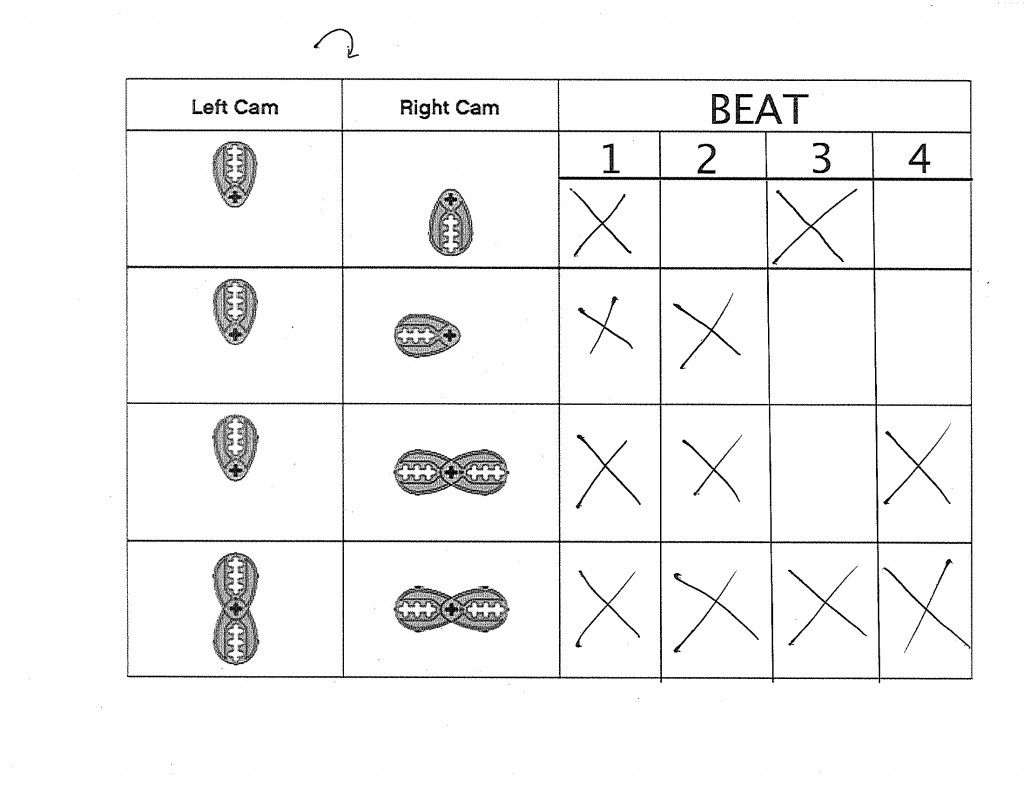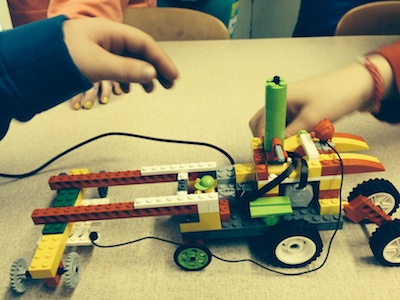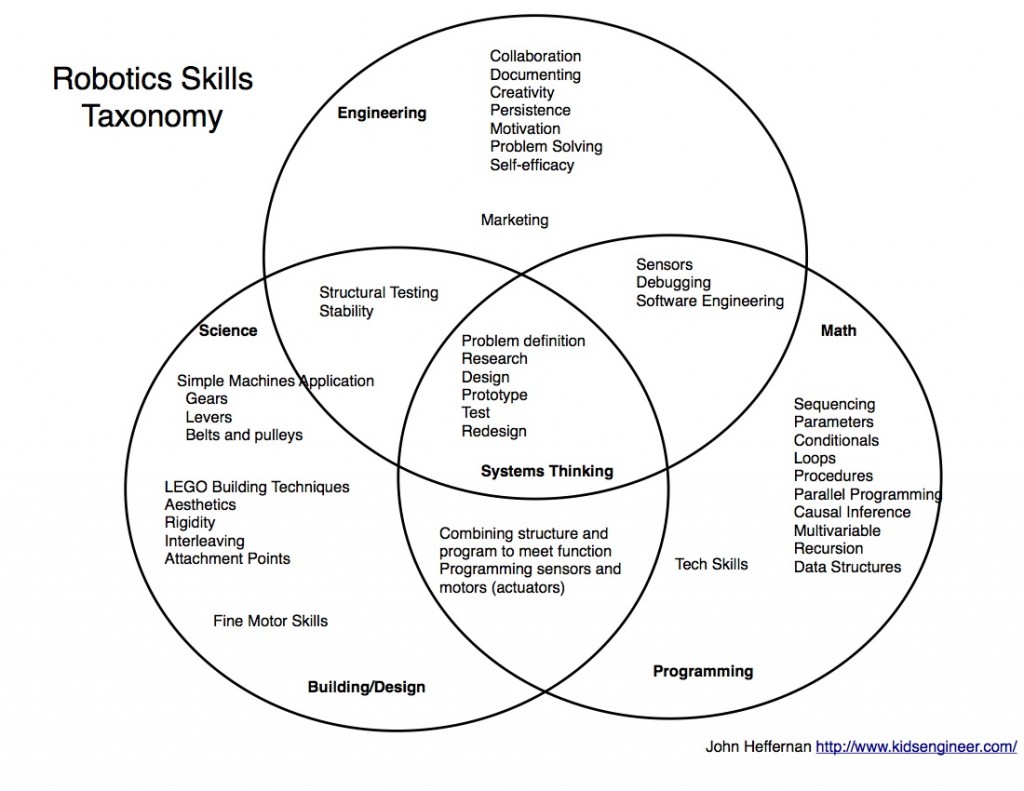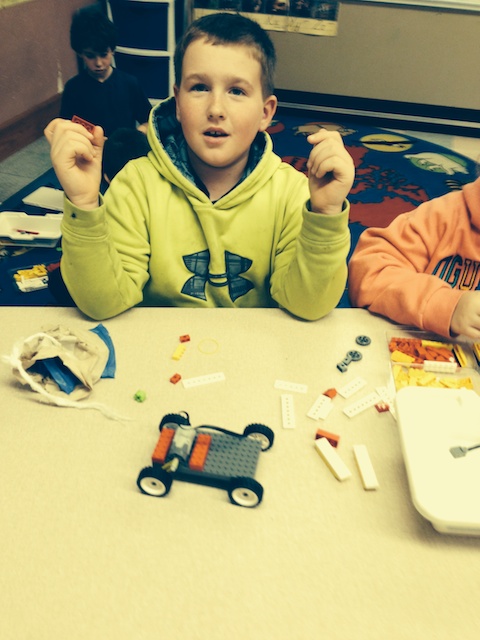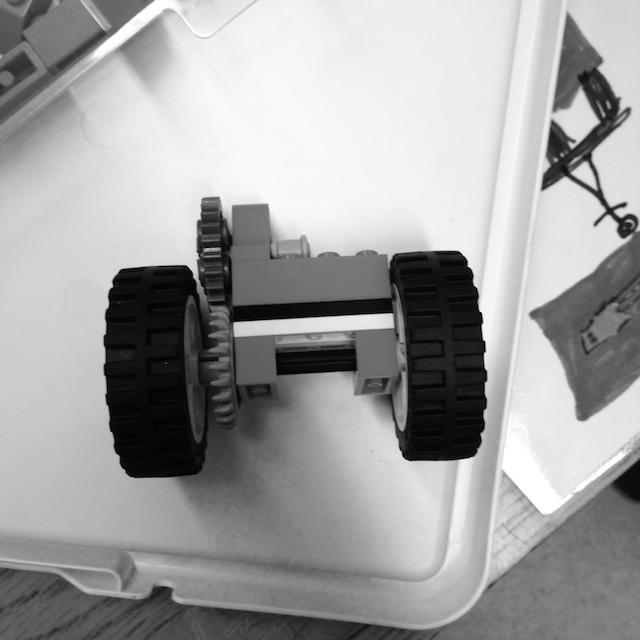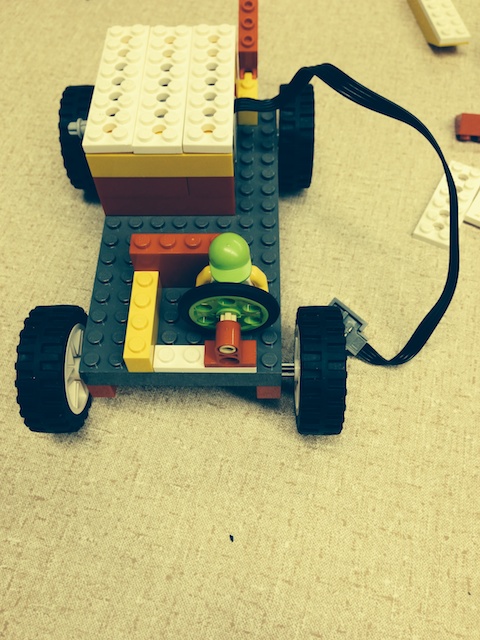Comprehensive Examination Proposal
Elementary Robotics Case Study
John Heffernan
University of Massachusetts, Amherst
March 19, 2014
Problem Statement
Designerly play has been identified as a fundamental component of childhood learning (Baynes, 1994). Designerly play is supported in typical preschool and kindergarten classes with sand tables, water tables, blocks, LEGOs, art, and dramatic play areas. However, as students enter grade one and beyond, the increasing academic focus has resulted in the loss of opportunities for designerly play (Zhao, 2012). At the same time, there are increasing calls to increase the number, skill, and diversity of STEM workers (Brophy, Portsmore, Klein, & Rogers, 2008). My thesis is that the lack of opportunities for designerly play in elementary school results in a reduction of the number and diversity of students interested in the STEM fields (especially engineering) later in school. Elementary engineering curriculum such as the robotics based Elementary Engineering Curriculum (Heffernan, 2013) and more general Engineering Is Elementary (Ernst & Bottomley, 2011) have the potential to ameliorate this problem. Robotics offers specific affordances that make it an especially attractive educational technology (Brophy et al., 2008; Gura, 2011).
A brief review of the existing research on robotics and design in general follows. Because so few studies have been done, I include studies across a wide age range. Also, design process models and methodologies of older learners may still be applicable (with modification) to studies of elementary students.
Previous studies have investigated different aspects of design and engineering as a means of teaching science concepts and process skills (Puntambekar & Kolodner, 2005), engineering (Hynes, 2007), problem solving (Fortus, Krajcik, Dershimer, Marx, & Mamlok-Naaman, 2005), and systems thinking (Sullivan, 2008). These studies have been of limited duration, have focused on older children, and have looked at the overall educational efficacy of the intervention.
Other studies have examined the novice design processes of learners in different contexts, ages, and have used different learning and process models. McRobbie, Stein, & Ginns (2001) analyzed the novice design practices of preservice teachers. They found that novice teachers did not follow the idealized practices found in engineering design process models. Roden (1999) looked at changes in the design process from infant school to primary school in Great Britain over a period of two years. He classified the collaborative problem solving strategies as: personalization, identification of wants and needs, negotiation and reposing the task, focusing on the task, tools, and materials, practice and planning, identifying difficulties, talking self through problems, tackling obstacles, sharing and cooperating, panic or persistence, showing and evaluating. Each strategy was judged as: declining, emerging, developing, and changing over time. The study showed that these strategies do change over time and he suggests that teachers need to understand them and help children make them explicit. Roden included cognitive, social, and emotional strategies in his analysis.
Crismond (2001) compared novice and expert high school and adult designers as they tried to redesign some common household tools. Each teams’ activities was coded and analyzed in terms of an idealized design process model. Crismond found the teams did not follow the idealized model. Furthermore, only the expert designers used general principles and connections to science concepts to help their design process. Crismond concluded that teacher must scaffold design tasks for this reason.
Fleer (1999) looked at design at for 5 and 11 years olds in terms of how their intended designs relate to what they actually built. She found that drawings were not always used. However, post-make drawing, especially by the older students provided good documentation of design choices. Older students still engaged in fantasy play associated with the design task but in a more subdued and socially acceptable way. They showed a preference for using 3-D models (i.e., the actual materials) to solve design problems.
Portsmore (2011) looked at preplanning for grade 1 students and found that even first grade students could sometimes used effective preplanning in a design task with familiar materials. Welch (1999) studied grade 7 students in a design task, coded what they were doing, and compared that to an idealized design process. He found that students did not follow an idealized design process. The evaluated their design much more frequently, tried one idea at a time instead of evaluating alternatives, and preferred 3 dimensional materials over 2 dimensional sketches.
K-12 robotics engineering, which typically uses design challenges, has been identified as a promising and effective way to incorporate engineering into K12 (Brophy et al., 2008). Multiple studies have pointed out the need for teacher scaffolding in the design process (Crismond, 2001; McRobbie et al., 2001; Puntambekar & Kolodner, 2005). However, elementary children’s design processes are not well understood. This proposed research fills a need for systematic description and analysis of the design processes undertaken by young children over time in the context of an established and systemic robotics based elementary engineering curriculum.
Project Overview
The comprehensive examination will consist of a literature review and pilot study (with accompanying papers) designed as preparation to provide the theoretical framework and methodologies needed to answer the expected dissertation research question: how do grade K to 6 elementary students’ robotics engineering skills and processes change over time in terms of construction and programming techniques? Specifically, what changes in their techniques and processes can be seen over time that impact their ability to realize their design ideas? The literature review will answer the question: what are the most relevant frameworks, design process models, and research methodologies that can be used or modified in a longitudinal case study of elementary robotics students in the context of established K-6 elementary robotics curriculum (Heffernan, 2013)? The pilot study will establish the methodologies needed for the dissertation research by doing a small subset of the case study and determining the exact research protocols to use in the larger, cross-sectional, longitudinal study. The following questions will be answered.
• What will be the exact coding of videotape? Will they use temporal and/or summative?
• How can the developmental strengths and challenges of each age be identified more formally?
• What design process model best fits this study and age range?
• What is the best design task to use for the dissertation study?
Literature Review Paper
Although robotics has been identified as a promising way to increase STEM interest and also teach science concepts (Brophy et al., 2008), there is no research of student use of robotics in a sustained program. More research is needed to understand how to teach engineering to students as their cognitive, motor, and social skills develop (Penner, Giles, Lehrer, & Schauble, 1997; Roth, 1996). The studies that do exist show promising results for short term robotics programs in middle and high school (Hynes, 2007; Sullivan, 2008). The goal of the literature review is to determine the most relevant frameworks, design process models, and methodologies that can be used or modified in a longitudinal case study of elementary robotics students in the context of established K-6 elementary robotics curriculum (Heffernan, 2013). The overall aim is to optimize the curriculum and, more generally, to optimize the teaching of engineering with regard to elementary student development.
Pilot Study
The author has created and documented a complete, standards-aligned, robotics-based, K-6 engineering curriculum that has been in use for many years (Heffernan, 2013). It contains a mix of open-ended engineering challenges and more teacher-directed activities. Students receive five to twenty hours of robotics curriculum per year from grades K to 6. While the curriculum has been thoroughly tested in a number of schools, the next step in its refinement is to determine how teachers can better scaffold students’ engineering processes from grade to grade. To do that, students’ processes first need to be characterized in a systematic manner.
The pilot study will consist of a cross sectional, qualitative case study that examines two students at grades 2 and 6 as they implement the same open-ended engineering challenge with age appropriate robotics and craft materials. These materials will be ones that they have used in the classroom robotics curriculum and will change according to the grade level. Students will be invited to describe and capture their initial ideas and plans through talking, writing, and/or drawing. Students will be videotaped to capture their building moves. Their programming moves will also be captured. Through a think-aloud protocol and semi-structured clinical interview, their verbal discourse will also be captured.
Data that helps characterize the designs will also be captured: elapsed time of design activity, design artifacts, photos of the completed design, and number of pieces and programming steps used. The bulk of the analysis will focus on the time spent in the process on different activities such as planning, tinkering, researching, building, rebuilding, programming, reprogramming, and evaluating. The data will then be examined at to see how and if these change as students age. Also, any common age related challenges to realizing their design ideas will be identified. Differences between how students design and build in the classroom and in this more unstructured research setting will also be noted. This indicates how much of the regular classroom curriculum has been internalized for the students. The pilot study will specify the exact methodologies, codes, and research protocol needed for the larger dissertation study.
Conclusion
In my current collection of about 200 papers on design, engineering, and robotics, I was only able to find three longitudinal studies. Roden’s (1997, 1999) early study tried to broadly induce cognitive, affective, and social problem solving strategies at two points in early childhood. Fleer (1999) did some early, cross sectional work on characterizing the relationship between design and the artifacts actually produced in a design problem at ages five and eleven. English, Hudson, & Dawes (2013) are doing a longitudinal study of middle school students simple machine based designs. However, they are not looking at how students change over time but are more interested in the complete educational systems of teachers, students, and materials. More research is needed examine and better understand how to teach engineering to students especially at the elementary level and, more specifically, how students design processes change over time (Crismond & Adams, 2012; Penner et al., 1997; Roth, 1996). A longitudinal study of elementary design processes will fill in important gap in the research base to help elementary teachers provide the appropriate scaffolding at each rapidly development stage of school age children’s development.
The literature review will identify the most relevant frameworks, design process models, and methodologies that could be used for such a study. The pilot study will analyze videotape of two elementary students of two different ages as they complete an open-ended robotics-based engineering challenge. Through a combination of talk-aloud (Sullivan, 2008), direct observation, and semi-structured clinical interview, various coding schemes based on the ones described here will be tried and possibly modified to characterize student’s engineering processes over time with particular focus identifying on the challenging aspects at different ages. Once these are identified, difficulties will be tied back to the matching development milestones provided by the theoretical frameworks of Piaget and others to better inform instruction and curriculum design for elementary engineering in a developmentally appropriate way. The literature does not provide guidance nor is it clear on how to identify strengths at different ages besides subjective, inductive analysis. A more systemic approach for identifying strengths may emerge from the pilot study. Levy & Mioduser (2010) showed that complex and advanced cognition can occur in young children’s interpretation of robot rules and behaviors, likewise, similar understandings need to be uncovered for the construction and programming of educational robots. In light of the Next Generation Science Standards (“Next Generation Science Standards,” 2012) incorporation of engineering design as a way to teach science K-12, any research that helps teachers teach engineering design in a developmentally appropriate way has timely relevance.
References
Applefield, J., Huber, R., & Moallem, M. (2000). Constructivism in theory and practice: Toward a better understanding. The High School Journal;, 84(2), 35.
Baynes, K. (1994). Designerly play. Loughborough: Loughborough University of Technology, Department of Design and Technology.
Brophy, S., Portsmore, M., Klein, S., & Rogers, C. (2008). Advancing Engineering Education in P-12 Classrooms. Journal of Engineering Education, 97(3).
Crismond, D. (2001). Learning and using science ideas when doing investigate-and-redesign tasks: A study of naive, novice, and expert designers doing constrained and scaffolded design work. Journal of Research in Science Teaching, 38(7), 791–820.
Crismond, D., & Adams, R. S. (2012). The informed design teaching and learning matrix. Journal of Engineering Education, 101(4), 738–797.
English, L. D., Hudson, P., & Dawes, L. (2013). Engineering-Based Problem Solving in the Middle School: Design and Construction with Simple Machines. Journal of Pre-College Engineering Education, 3(2). Retrieved from http://search.ebscohost.com/login.aspx?direct=true&profile=ehost&scope=site&authtype=crawler&jrnl=21579288&AN=92609426&h=ht05k9am%2Ftl2QOU10jBAcagHyYxbrbL5QLpZyclHMmSLkzUB%2FYLBo6kmakVxYabX12tvjZ1iZfSRTKmxqBdJxg%3D%3D&crl=c
Ernst, J. V., & Bottomley, L. (2011). AC 2011-227: ELEMENTARY ENGINEERING IMPLEMENTATION AND STUDENT LEARNING OUTCOMES. Retrieved from http://www.asee.org/file_server/papers/attachment/file/0001/0688/NIH_Paper_3_10_11.pdf
Fleer, M. (1999). The science of technology: Young children working technologically. International Journal of Technology and Design Education, 9(3), 269–291.
Fortus, D., Krajcik, J., Dershimer, R. C., Marx, R. W., & Mamlok-Naaman, R. (2005). Design‐based science and real‐world problem‐solving. International Journal of Science Education, 27(7), 855–879. doi:10.1080/09500690500038165
Gura, M. (2011). Getting Started with LEGO Robotics: A Guide for K-12 Educators [Paperback]. Eugene, OR: ISTE.
Heffernan, J. (2013). Elementary Engineering: Sustaining the Natural Engineering Instincts of Children. Charlestown, SC: Printed by CreateSpace.
Hynes, M. (2007). AC 2007-1684: IMPACT OF TEACHING ENGINEERING CONCEPTS THROUGH CREATING LEGO-BASED ASSISTIVE DEVICES. Presented at the American Society for Engineering Education Annual Conference & Exposition, Honolulu,HI: American Society for Engineering Education. Retrieved from http://icee.usm.edu/ICEE/conferences/asee2007/papers/1684_IMPACT_OF_TEACHING_ENGINEERING_CONCEPTS_.pdf
Levy, S. T., & Mioduser, D. (2010). Approaching Complexity Through Planful Play: Kindergarten Children’s Strategies in Constructing an Autonomous Robot’s Behavior. International Journal of Computers for Mathematical Learning, 15(1), 21–43. doi:10.1007/s10758-010-9159-5
McRobbie, C. J., Stein, S. J., & Ginns, I. (2001). Exploring designerly thinking of students as novice designers. Research in Science Education, 31(1), 91–116.
Next Generation Science Standards. (2012). Retrieved November 2, 2012, from http://www.nextgenscience.org/
Papert, S. (1993). Mindstorms: Children, Computers, And Powerful Ideas (2nd ed.). Basic Books.
Penner, D. E., Giles, N. D., Lehrer, R., & Schauble, L. (1997). Building functional models: Designing an elbow. Journal of Research in Science Teaching, 34(2), 125–143.
Portsmore, M. D. (2011). AC 2011-1780: FIRST GRADE STUDENTS PLANNING AND ARTIFACT CONSTRUCTION WHILE WORKING ON AN ENGINEERING DESIGN PROBLEM. Presented at the ASEE Annual Conference, Vancouver, BC, Canada. Retrieved from http://jee.asee.org/file_server/papers/attachment/file/0001/1710/Draft_Portsmore_ASEE2011v2.pdf
Puntambekar, S., & Kolodner, J. L. (2005). Distributed Scaffolding: Helping Students Learn Science from Design. Journal of Research in Science Teaching`, 42(2), 185–217.
Roden, C. (1997). Young children’s problem-solving in design and technology: towards a taxonomy of strategies. Journal of Design & Technology Education, 2(1). Retrieved from https://jil.lboro.ac.uk/ojs/index.php/JDTE/article/view/375
Roden, C. (1999). How children’s problem solving strategies develop at Key Stage 1. Journal of Design & Technology Education, 4(1). Retrieved from http://ojs.lboro.ac.uk/ojs/index.php/JDTE/article/view/404
Roth, W.-M. (1996). Art and Artifact of Children’s Designing: A Situated Cognition Perspective. Journal of the Learning Sciences, 5(2), 129–166.
Sullivan, F. R. (2008). Robotics and science literacy: Thinking skills, science process skills and systems understanding. Journal of Research in Science Teaching, 45(3), 373–394. doi:10.1002/tea.20238
Vygotsky, L. (1978). Mind in Society: The Development of Higher Order Psychological Processes. In Mind in Society: The Development of Higher Order Psychological Processes.
Welch, M. (1999). Analyzing the Tacit Strategies of Novice Designers. Research in Science & Technological Education, 17(1), 19–33.
Zhao, Y. (2012). World class learners: Educating creative and entrepreneurial students. SAGE.

